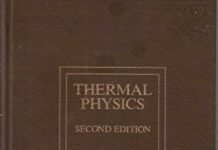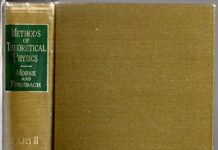
Ebook Info
- Published: 1987
- Number of pages: 949 pages
- Format: PDF
- File Size: 14.23 MB
- Authors: Philip M. Morse
Description
This volume, available for the first time in paperback, is a standard work on the physical aspects of acoustics. Starting from first principles, the authors have successfully produced a unified and thorough treatment of the subjects of generation, propagation, absorption, reflection, and scattering of compressional waves in fluids, progressing to such topics as moving sound sources, turbulence, and wave-induced vibration of structures. Material is included on viscous and thermal effects, on the acoustics of moving media, on plasma acoustics, on nonlinear effects, and on the interaction between light and sound. Problems, with answers in many cases, are given at the end of each chapter. They contain extensions to further applications, thus enhancing the reference value of the book. Many of the examples worked out in the text and in the problem solutions were not previously published. Anyone familiar with calculus and vector analysis should be able to understand the mathematical techniques used here.
User’s Reviews
Editorial Reviews: Review “This impressive book by two distinguished workers in theoretical acoustics brings together both standard and novel mathematical methods now available to workers in acoustics. The result is a masterful achievement that should be indispensable for research workers and teachers in acoustics and related fields in engineering and science.”—Ambrose Swasey, Physics Today From the Back Cover Starting from first principles, the authors have successfully produced a unified and thorough treatment of the subjects of generation, propagation, absorption, reflection, and scattering of compressional waves in fluids, progressing to such topics as moving sound sources, turbulence, and wave-induced vibration of structures.
Reviews from Amazon users which were colected at the time this book was published on the website:
⭐I bought this book for two reasons: 1) I was beginning some experiments with ultrasonics, and I wanted a “handbook” of sorts. 2) In addition to these experiments, I was wondering if I could attempt some Finite Element modelling, and I needed a book that could help me translate stress-strain data to acoustics.For #1, I was somewhat disappointed, but it’s my fault. This book is a dense, theoretical exploration of the topic of acoustics. It’s first principles, through and through. It is not a quick reference handbook, not really a book you can flip through and say “oh… yes. I’ll have to remember that.” I was hoping for some detailed examples, but instead I’ve gotten more than I ever asked for. In some ways, I suppose this can be a good thing, but in others, it isn’t.For #2, I found everything I need to know in the first 6 pages. Really. Start with F = d/dt(mv) and go from there (I suppose F = ma just doesn’t look complicated enough). After that, the book is already into Bessel functions in 1000 words or less.I was really hoping for a page somewhere that said: Maxwell’s Equations for Acoustics (complete with analogies between E&M and acoustics). I didn’t find it. Maxwell’s Equations are mentioned on page 799-800, on a mathematical assault of “magnetoacoustic waves”.This book is a lot like John David Jackson’s “Classical Electrodynamics”. It is *the* book, the comprehensive book, the one that all of the graduate students regard with an uncomfortable mixture of deep respect and dread. This dense, heavy book is good for slapping somebody around, both literally and figuratively. Reading through the book makes me wonder how in the heck I ever got a Ph.D. when there were people out there writng books like this. I can’t give it 5 stars because I don’t see how anyone can get anything out of the book without devoting half of their life to it, but I give it at least 4 stars because it’s more than a person will ever need to know about acoustics. It’s a masterpiece, but not practical for the scientist looking for a good reference text.
⭐Happy with purchase
⭐Ok good book
⭐Overall the depth of this text is exceptional. Morse and Ingard’s greatest strength is their skill at explaining the physics behind the mathematics in appropriate terms: with simple expositions when possible, but with unapologetic complexity when that is what is required to properly and precisely motivate a discussion. Exercises provided at the end of each chapter are usually challenging without being so difficult they end up discouraging the student.Unfortunately the authors’ precision is not matched by this edition’s typesetters. A single errata page is included on one of the front leaves, but as the reader goes through the text he or she will quickly realize that it is littered with typesetting errors. An accurate and comprehensive list of errata would cover much more than a single page. In some cases the printers have scribbled in corrections by hand. Equation and section number references are also sometimes incorrect. Previous hardcover editions don’t seem to have these issues. If you can find one, you’re better off paying a few extra dollars to get it. In no way is this edition suitable as an assigned textbook for a university acoustics course, although it’s invaluable a secondary reference.
⭐I am constantly amazed by this remarkable book. It remains a topical reference for theoretical methods in acoustics, despite the advent of computational methods that allow modern acousticians to solve models on their desktop. I recently had the job of reviewing a patent for an acoustic transducer — and sure enough I found this “modern” idea in good-ol’ Morse and Ingard. In my opinion it is a must.
⭐As luck would have it, I bought this book to get one equation, Eq 11.2.15 on page 724, which had been referenced in a couple of papers I had been reading. The exponent in the denominator of the second term did not look right to me, and my brother (PhD Physics) quickly confirmed the exponent should be 3, and not 2 as printed in this edition. Is this a typo, or a boo boo? I don’t know, but it does not give one a warm fuzzy feeling. The book covers an amazing range of material.
⭐A classical text from former MIT professors. A must buy for fundamentals of acoustics.
⭐Quite dense but well explained
Keywords
Free Download Theoretical Acoustics in PDF format
Theoretical Acoustics PDF Free Download
Download Theoretical Acoustics 1987 PDF Free
Theoretical Acoustics 1987 PDF Free Download
Download Theoretical Acoustics PDF
Free Download Ebook Theoretical Acoustics

